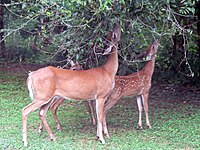
Photo from wikipedia
Terrestrial tri-trophic interactions account for a large part of biodiversity, with approximately 75% represented in plant–insect–parasitoid interactions. Herbivore diet breadth is an important factor mediating these tri-trophic interactions, as specialisation… Click to show full abstract
Terrestrial tri-trophic interactions account for a large part of biodiversity, with approximately 75% represented in plant–insect–parasitoid interactions. Herbivore diet breadth is an important factor mediating these tri-trophic interactions, as specialisation can influence how herbivore fitness is affected by plant traits. We investigated how phytochemistry, herbivore immunity, and herbivore diet breadth mediate plant–caterpillar–parasitoid interactions on the tropical plant genus Piper (Piperaceae) at La Selva Biological station in Costa Rica and at Yanayacu Biological Station in Ecuador. We collected larval stages of one Piper generalist species, Quadrus cerealis, (Lepidoptera: Hesperiidae) and 4 specialist species in the genus Eois (Lepidoptera: Geometridae) from 15 different species of Piper, reared them on host leaf material, and assayed phenoloxidase activity as a measure of potential larval immunity. We combined these data with parasitism and caterpillar species diet breadth calculated from a 19-year database, as well as established values of phytochemical diversity calculated for each plant species, in order to test specific hypotheses about how these variables are related. We found that phytochemical diversity was an important predictor for herbivore immunity, herbivore parasitism, and diet breadth for specialist caterpillars, but that the direction and magnitude of these relationships differed between sites. In Costa Rica, specialist herbivore immune function was negatively associated with the phytochemical diversity of the Piper host plants, and rates of parasitism decreased with higher immune function. The same was true for Ecuador with the exception that there was a positive association between immune function and phytochemical diversity. Furthermore, phytochemical diversity did not affect herbivore immunity and parasitism for the more generalised herbivore. Results also indicated that small differences in herbivore diet breadth are an important factor mediating herbivore immunity and parasitism success for Eois at both sites. These patterns contribute to a growing body of literature that demonstrate strong cascading effects of phytochemistry on higher trophic levels that are dependent on herbivore specialisation and that can vary in space and time. Investigating the interface between herbivore immunity, plant chemical defence, and parasitoids is an important facet of tri-trophic interactions that can help to explain the enormous amount of biodiversity found in the tropics.
Journal Title: Frontiers in Plant Science
Year Published: 2018
Link to full text (if available)
Share on Social Media: Sign Up to like & get
recommendations!